
Saturn Bomberman is an action video game by Hudson Soft for the Sega Saturn. The twelfth installment in the Bomberman series, it was first released in Japan on July 19, 1996, in Europe in May 1, 1997, and in North America in September 4, 1997. It is best known for its multiplayer functionality for up to ten players. The game received praise from critics for its enjoyable gameplay and multiplayer, but received criticism for not advancing the Bomberman series enough beyond previous installments.
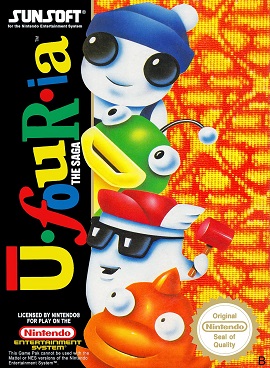
Ufouria: The Saga is a 1991 action-adventure video game developed and published in Japan and Europe by Sunsoft for the Nintendo Entertainment System. It is the first entry in the Hebereke franchise, where almost every installment in the series features a completely different playstyle. Controlling a humanoid-looking character called Bop-Louie through an interconnected world, the game focuses on exploration and searching for items and power-ups in vein of Metroid and Blaster Master, fighting bosses and minibosses. During gameplay, the player locates the main character's three friends, each of which becomes a playable character and have unique skills that allow the player to reach previously inaccessible areas.

Galaxy Fight: Universal Warriors is a fighting game originally developed and published by Sunsoft in 1995 for the Neo-Geo MVS in arcades, and then for the Neo Geo AES console. It was Sunsoft's second fighting game after their 1994 Super Famicom spin-off of their Hebereke series, Sugoi Hebereke, as well as their first side-viewed 2D fighting game.

Tetris Plus is a puzzle video game developed and by Jaleco for arcades in 1996, and ported to the Sega Saturn, PlayStation, and Game Boy later that year. The game would be followed by a sequel, Tetris Plus 2, in 1997. Ports were to be developed for the Atari Jaguar and Nintendo 64 but these were never released.

Mario's Picross is a 1995 puzzle video game for the Game Boy. Developed by Jupiter and Ape and published by Nintendo, it is a compilation of nonogram logic puzzles. The game stars Mario who chisels away at puzzle grids to form pictures. The game initially received positive reviews, with reviewers citing its length and addictive nature as a positive, but its grid sizes and absence of typical Mario elements as a negative.
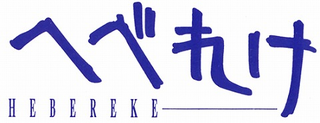
Hebereke is a video game series developed by Sunsoft that was released primarily in Japan, with a few releases in Europe and one release in North America. It was one of the company's main franchises during the 1990s.
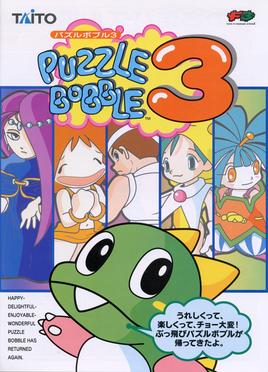
Puzzle Bobble 3 is an action puzzle video game developed by Taito. The second sequel to Puzzle Bobble, it was released for arcades in September 1996 and later ported to the Sega Saturn, PlayStation, Game Boy, Nintendo 64 and Microsoft Windows. Like its predecessors, the player is tasked with shooting balls at groups of balls, creating groups of three or more, which are then removed from play. Further ports for the Nintendo Switch, PlayStation 4 and Xbox One were released in February 2023 by City Connection alongside Puzzle Bobble 2.
Sun Corporation, operating under the name Sunsoft, is a Japanese video game developer and publisher.

Waku Waku 7 is a 2D fighting game developed and published by Sunsoft initially as an arcade game for the Neo Geo MVS arcade system in 1996 worldwide.

Astra Superstars (アストラスーパースターズ) is a 1998 2D versus fighting arcade game illustrated and designed by Santaclaus, developed and published by Sunsoft, and distributed by Tecmo in Japan on June 6, 1998. It is Sunsoft's fourth fighting game after the 1994 Super Famicom Hebereke franchise spin-off Sugoi Hebereke, the 1995 Galaxy Fight: Universal Warriors and the 1996 Waku Waku 7. It is powered by the Sega Saturn-based ST-V arcade system. Astra Superstars is an airborne-based fighting game.

Baku Baku, released in Japan as Baku Baku Animal, is a falling block puzzle arcade game released by Sega in 1995. The game is dedicated as Sega's first ever Network Compatible PC Game. A Sega NetLink compatible version of the game was also announced, but never released.

Hebereke's Popoon is a two player puzzle video game developed and published by Sunsoft. It is based on the Hebereke series. Hebereke means drunk or untrustworthy. Popoon is an onomatopoeia for the sound made by the game pieces when they explode.

Hashire Hebereke (はしれへべれけ) is a 1994 racing game developed and published by Sunsoft exclusively in Japan for the Super Famicom on December 22, 1994. The game is the fifth installment in the Hebereke series. It was also re-released for Project EGG as a Windows Store title on October 11, 2011 in Japan.
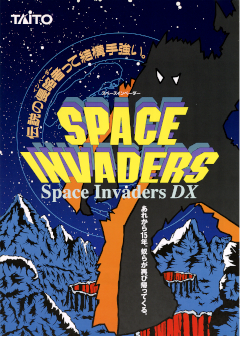
Space Invaders DX is a 1993 fixed shooter arcade game developed and published in Japan by Taito. It has been re-released for several consoles since, including the Super Nintendo Entertainment System, PC Engine Super CD, and Sega Saturn — several of these conversions use the name Space Invaders: The Original Game. The player assumes control of a laser base that must fend off waves of incoming enemies, who march down in formation towards the bottom of the screen. It is the fifth entry in the long-running Space Invaders series. DX contains four variations of the original Space Invaders, in addition to a multiplayer mode and a "Parody Mode" that replaces the characters with those from other Taito franchises. Home ports of DX received mixed reviews for their high price point and general lack of content.

Pic Pic, known in Japan as PikuPiku: Toku to E Ninaru Mitsu no Puzzle, is a puzzle video game by Success for the Nintendo DS. The game is divided into 3 different logic-based picture puzzle games: Maze Paint, Drawing and Magipic.
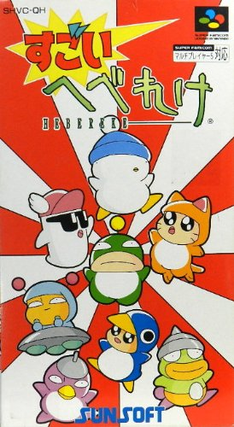
Sugoi Hebereke is a 1994 fighting game developed and published by Sunsoft in Japan for the Super Famicom on March 11, 1994. It is a spin-off of the Hebereke series, as well as Sunsoft's first attempt in the genre before they became better known for the 1995 Galaxy Fight: Universal Warriors, the 1996 Waku Waku 7, and the 1998 Astra Superstars.
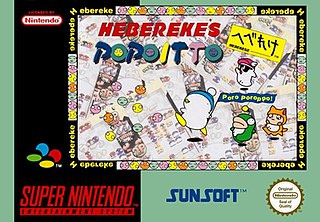
Hebereke's Popoitto is a puzzle-type video game in the Hebereke series developed by Sunsoft for the Sega Saturn, PlayStation and SNES consoles. Although released in Japan and Europe during 1995 and 1996, it was never released in North America. The gameplay is reminiscent to video game titles like Dr. Mario and Puyo Puyo. Hebereke's Popoitto received generally positive reviews, and was mostly recommended for fans of the puzzle genre.
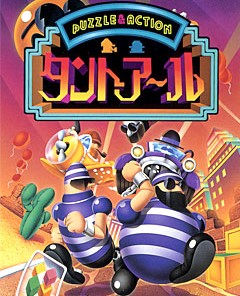
Puzzle & Action: Tant-R, is a puzzle video game developed and published by Sega in 1993 for the Sega System C in Japan. The first instalment in the Puzzle & Action trilogy, it is a spin-off of Bonanza Bros.. The characters from Bonanza Bros., Robo and Mobo, are featured as protagonists, functioning as detectives. A prison escapee is chased, and his henchmen interfere. A series of timed mini-games must be completed to defeat the henchmen. The game features references to western culture.

Puzzle & Action: Ichidant-R (also known as just Ichidant-R is a puzzle video game developed and released by Sega in 1994 for the Sega System C-2. It is the sequel to Puzzle & Action: Tant-R and is the second of the Puzzle & Action series. Gameplay is similar to Tant-R: the player must complete a series of mini-games, although its crime theme is replaced with a medieval theme. The detectives from the first game return and play the role of knights in a theatre play. An English version of the game exists, which replaces the Japanese voices with English voices. The Korean version also uses the English voices. The game was ported to the Game Gear in 1994, Mega Drive in 1995, and released on the Sega AgesRouka ni Ichidant-R compilation for the Sega Saturn. The game was released for the Wii Virtual Console in 2007. All console versions except for the Switch version are Japanese exclusives. The third and final game in the series, Puzzle & Action: Treasure Hunt, was released in 1995.

Puzzle & Action: Treasure Hunt, known in Japan as Puzzle & Action: Nidoarukoto wa Sand-R (2度あることはサンドア〜ル), and as Puzzle & Action: Sand-R, is a puzzle video game released for the Sega Titan Video in 1995, and ported to the Japanese Sega Saturn by CRI in 1996. The Saturn version was re-released for the Satakore range in 1998. Puzzle & Action: Treasure Hunt is the third and final instalment in the Puzzle & Action series, after Puzzle & Action: Tant-R and Puzzle & Action: Ichidant-R. Like the previous games, players play a series of timed mini games to overcome enemies. Two players are supported.




















